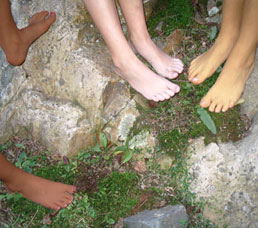Overview of Grade 4 Curriculum
Which Properties Change and Which Stay the Same?


Look down, what’s under your feet? Carpet or grass? Sand or cement? Over the next couple of months we’ll metaphorically step outside to investigate earth materials, such as rock, sand, clay, water, shells, and oil that are found on the surface of our planet.
Earth materials are complex and varied, and include both liquids and solids. These materials provide a rich context for ongoing study of important cross–grade concepts such as weight, volume, and density as we look for evidence that helps us make sense of this complexity.
The unit includes five sections. In Section 1, Underfoot, we investigate a variety of earth materials, examining and describing their properties. We discover that rocks can contain many different minerals. Through further investigation, we find evidence that minerals have some properties that stay the same regardless of the size of the sample. In Section 2, Heavy for Size, we measure the weight of liquid and granular samples of material, and think about which materials are “heavy for size.” In Section 3, The Liquid Materials, we measure both volumes and weights of liquids and compare the properties of oil and water. We focus on The Mineral Materials in Section 4, using water displacement to measure the volumes of rocks and of samples of granular material (such as sand). This gives rise to a discussion about how much space is between the particles, and what could fill those spaces. Finally, in the culminating Section 5, we consider Transformations, such as the natural grinding of earth materials, leading to consideration of the weathering processes. When an object, such as a shell or a rock, is transformed, what changes and what stays the same?
We hope to have a great time finding answers to the question: ”What’s underfoot?“ We suspect we’ll walk away from our investigations with increased understanding and appreciation of the natural materials that lie on Earth’s surface.




